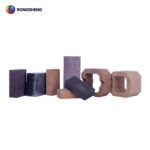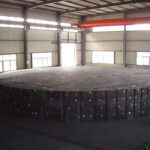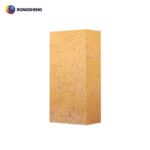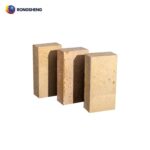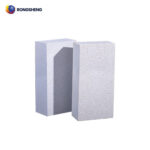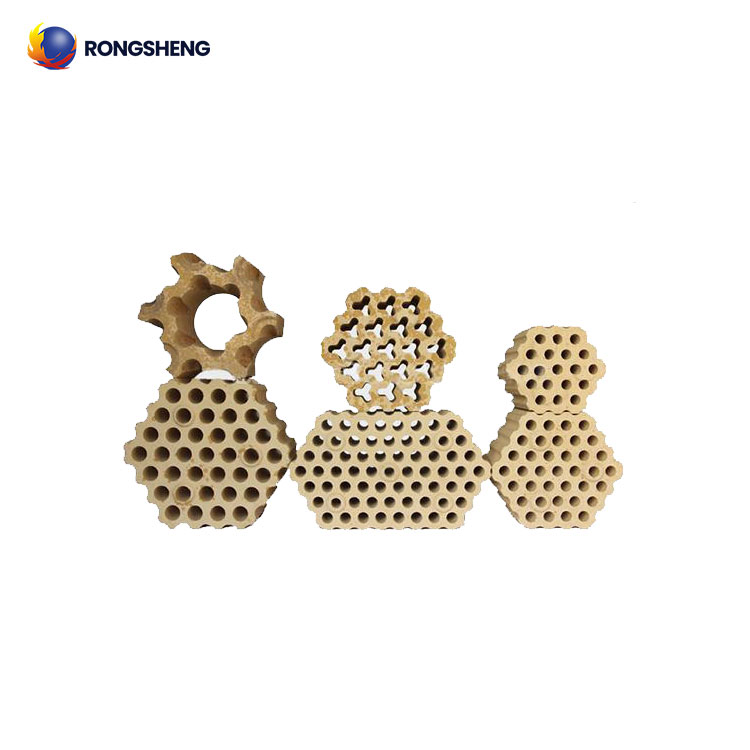
Checker Bricks
- Strong heat exchange capacity.
- Large heat storage area.
- Smooth ventilation.
- Good volume stability.
- Good high-temperature load creep performance.
We are Here to Help!
Email: sales@hy-refractory.com
WhatsApp: +86 185 3831 2977
Rongsheng Checker brick is a heat transfer medium and heat storage body that plays an important role in many fields. In industrial fields, such as hot blast furnaces, glass kilns and coke oven regenerators, checker bricks are used for heat exchange and heat storage. It has the characteristics of strong heat exchange capacity, large heat storage area, smooth ventilation, good volume stability, good high temperature load creep performance, high density, low porosity, etc. Rongsheng Refractory Manufacturer supplies high-quality checker bricks. Contact Rongsheng, and get detailed information for free.
Types of Checker Bricks
Checker bricks are rich in variety. According to different materials, they can be divided into clay checker bricks, high-alumina checker bricks, andalusite checker bricks, low creep checker bricks, siliceous checker bricks, sillimanite checker bricks, etc. Checker bricks of different materials have different performance characteristics and are suitable for different working environments and temperature conditions. For example, siliceous checker bricks have good high-temperature resistance and are often used in high-temperature areas; clay checker bricks perform well in low-temperature environments. In addition, according to different specifications, they can also be divided into 7-hole checker bricks, 19-hole checker bricks, 31-hole checker bricks, 37-hole checker bricks, etc. Checker bricks with different numbers of holes have different heat storage areas and heat transfer efficiency, thereby meeting the needs of different equipment and processes.
The Heat Conduction Principle of Checker Bricks
The heat conduction principle of checker bricks is mainly based on their special structure. The checker bricks are arranged with circular holes of equal size. This structure allows heat to accumulate in the holes. During use, for example, in equipment such as hot air furnaces, the checker bricks are laid on the bottom of the device before heating, and heat is transferred by conduction, convection and radiation. During conduction, heat is transferred from the high-temperature area to the low-temperature area through the solid part of the checker bricks. Convection is the transfer of heat through the flow of gas in the holes. In terms of radiation, the surface of the checker bricks can absorb and emit thermal radiation to promote heat exchange. This comprehensive heat conduction method enables the checker bricks to efficiently complete heat transfer, ensure that heat is not easily dissipated, and extend the accumulation time as much as possible, laying the foundation for subsequent heat conduction.
Load-bearing Capacity of Checker Bricks
Checker bricks have a strong load-bearing capacity. Their unique internal structure gives them this characteristic. Even after being stacked layer by layer, they can still withstand the additional pressure of heavy objects and avoid collapse or damage. Checker bricks are sometimes used in combination with other materials. In this case, they need to withstand the test of increasing weight. Their transparent grid holes can improve the pressure-bearing capacity of bricks, and the unique grooves are also conducive to the drainage of hot air. For example, in large industrial equipment such as blast furnaces, checker bricks need to withstand high temperatures, high pressures and the weight of various materials, and their strong load-bearing capacity ensures the stable operation and long-term use of the equipment.
Application of Checker Bricks
Role of Checker Bricks in Ironmaking
Checker bricks play a vital role in the ironmaking field. They are mainly used in hot blast furnaces and are an important heat transfer medium. Through their special internal structure, they can effectively transfer heat, thereby providing the necessary thermal energy support for the ironmaking process.
Specifically, in hot blast furnaces, checker bricks can accumulate the heat generated by combustion. Then release it when needed to heat the cold air and make it hot air. Providing high-temperature hot air to the ironmaking blast furnace helps to improve the efficiency and quality of ironmaking. In addition, the high stability, good thermal conductivity and strong load-bearing capacity of checker bricks enable them to adapt to the complex environment and high requirements in the ironmaking process.
For example, its shockproof design can discharge excess gas through holes to enhance its stability and safety.
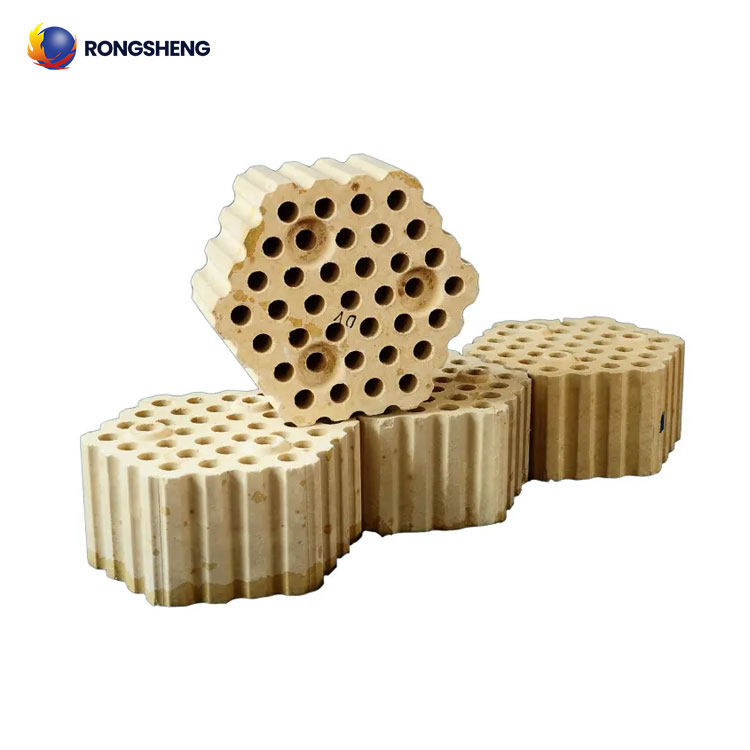
Application of Checker Bricks in Hot Blast Furnaces
Checker bricks play a vital role in hot blast furnaces. Hot blast furnaces are typical regenerative heat exchangers. Checker bricks, as their heat storage bodies, undertake the key tasks of absorbing and releasing heat.
During the furnace burning period, the high-temperature flue gas after combustion passes through the holes of the checker bricks and transfers heat to the checker bricks. During the air supply period, cold air enters the hot blast furnace from the blower, passes through the heated checker bricks and becomes hot air, and then is sent to the blast furnace through the hot air pipe for combustion reaction.
The material and specifications of the checker bricks will be selected according to the temperature requirements of different parts of the hot blast furnace. For the high-temperature area close to the combustion chamber, siliceous or high-alumina checker bricks with good high-temperature performance and strong anti-adhesion ability are usually selected. For the low-temperature area close to the cold air chamber, clay checker bricks with good low-temperature performance and high strength are selected.
For example, ironmaking plants have significantly increased the hot air temperature, reduced fuel consumption, and improved ironmaking efficiency and economic benefits by optimizing the configuration of checker bricks in hot blast furnaces.
The Role of Checker Bricks in Glass Melting Furnaces
Checker bricks play an important role in glass melting furnaces. Glass melting furnaces are key equipment for glass manufacturing, and checker bricks, as part of the waste heat recovery device, use checker bricks made of refractory materials to store the heat of high-temperature flue gas discharged from the kiln to heat the air entering the kiln.
When the high-temperature exhaust gas in the kiln flows through the checker bricks in the regenerator, the temperature of the checker bricks gradually increases. After the flame turns, the gas or air flowing through the checker bricks is heated, thereby ensuring that the flame has a high enough temperature to meet the needs of glass melting. The good performance of checker bricks helps to improve the energy utilization efficiency of glass melting furnaces and reduce production costs.
For example, some advanced glass manufacturers have improved the thermal efficiency of glass melting furnaces, reduced energy consumption, and improved the quality and output of glass by improving the material and structure of checker bricks.
Performance of Silicon Carbide Honeycomb Ceramic Checker Brick
Silicon carbide honeycomb ceramic checker brick has many excellent properties. It not only has excellent room temperature mechanical properties, such as high bending strength, good corrosion resistance, and low friction coefficient, but also maintains excellent performance at high temperatures. Its high temperature mechanical properties (strength, creep resistance, etc.) are excellent among known ceramic materials. High temperature strength can be maintained up to 1600℃, and its oxidation resistance is also the best among all non-oxide ceramics.
Silicon carbide honeycomb ceramic checker brick has good volume stability, excellent high-temperature load creep performance, high density, and low porosity, which enables it to work stably in the high-temperature environment of industrial furnaces and effectively resist high temperature and chemical erosion.
For example, in some high-temperature industrial furnace applications, the excellent performance of silicon carbide honeycomb ceramic checker bricks significantly improves the thermal efficiency of the furnace, extends its service life, and reduces maintenance costs and the risk of production interruptions.
Technical Development Trend of Checker Bricks
The technical development of checker bricks presents some obvious trends. With the continuous advancement of industrial technology, the performance requirements of checker bricks are getting higher and higher.
- On the one hand, the pursuit of higher heat exchange efficiency and larger heat storage area is to improve energy utilization efficiency. For example, the technological development of Kalugin top-fired hot blast furnace has enabled the maximum wind temperature of blast furnace hot blast furnace to reach 1350 degrees. The use of small-aperture checker bricks, such as 20 mm aperture checker bricks, reduces the amount of checker bricks and reduces investment costs.
- On the other hand, the material and manufacturing process of checker bricks are continuously improved to improve their high temperature resistance, corrosion resistance, and oxidation resistance, and extend their service life. At the same time, the research and development of new checker bricks that are suitable for different industrial furnace types and process requirements is also the future development direction. For example, the emergence of some new types of multiphase ceramic checker bricks has improved the toughness and strength of traditional checker bricks, bringing better performance and benefits to industrial production.
As an important heat transfer medium and heat storage body in the industrial field, checker bricks play a key role in hot blast furnaces, glass melting furnaces, and other equipment. With the continuous advancement of technology, checker bricks are constantly innovating and developing in terms of materials, specifications, performance, and applications to meet the increasing requirements of industrial production and energy conservation, and environmental protection. In the future, checker bricks are expected to play a more important role in improving energy efficiency, reducing production costs, and improving product quality, making greater contributions to industrial development.

